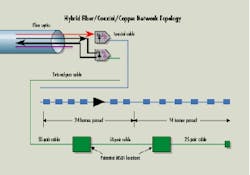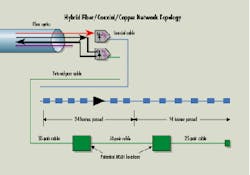Hybrid fiber, coaxial, and copper designs provide an out-of-the-box approach
Hybrid fiber, coaxial, and copper designs provide an `out-of-the-box` approach
By Donald T. GALL and MITCH SHAPIRO
Options abound for operators who choose from existing off-the-shelf electronics as needed to customize a network design.
What if you have a "greenfield" opportunity to offer switched telephony or "plain old television service" to create incremental revenues without sacrificing your core business? Your existing cable plant is in relatively good condition and delivering quality video to your subscribers, but you just don`t believe a hybrid fiber/coaxial (HFC) telephone system will offer the reliability you require. In addition, other things being equal, if you offer telephony you would want to stick with proven technology with as little risk as possible.
Today`s state-of-the-art telecommunications systems (both telephone company and cable television) have been vastly improved with the advent of transport fiber optics. However, there are still significant roadblocks to building a single cost-effective communications network that does everything well. Twisted-pair networks struggle with bandwidth and switching needs, while coaxial networks struggle with reliability and powering issues. Both networks individually have provided practical solutions in their respective core businesses, but there are technical and financial hurdles to overcome to create a truly integrated solution that delivers voice, data, and video. While it`s desirable to be on the cutting edge of technology, it`s usually best to be just behind the blade!
Under the right circumstances, a network that uses both twisted-pair and coaxial technologies as an integrated system combines the best of both worlds and may be just the ticket. This alternative architecture provides twisted-pair distribution with a different perspective by keeping the number of copper pairs small to reduce weight on the overlashed coaxial plant and reduce construction and splicing labor. While this approach is more cost-effective than traditional full copper telephony methods, its business model only works if a significant percentage of the switched telephony business can be captured. The coaxial portion can be a typical HFC format--an evolutionary, not revolutionary, approach to convergence, variations of which have been successfully deployed in the United Kingdom, and parts of Europe.
A hybrid fiber/ coaxial/copper (HFCC) architecture uses existing off-the-shelf products to build a highly reliable and cost-effective network that overcomes the inherent problems of conventional single network approaches. It is capable of delivering all existing applications such as analog and digital video, high-speed analog and digital subscriber loop (DSL) data services as well as future applications like demand side management (DSM) and video on demand (VOD).
A key to deploying an HFCC-like architecture is to avoid designing a network from the "monopoly" perspective. Without the benefit of 100% penetration or a guaranteed rate of return on capital, successful network operators must find ways to deploy technology incrementally to fit their business plans. It is this ability to deploy electronics only as needed that makes the HFCC model a viable approach.
The transport portion of the combined HFCC plant is fiber optics, which provides the necessary bandwidth and low losses to allow the deployment of services across large areas. The actual network design will depend on the individual companies` business plan and the size of the serving areas. At the node serving area, fiber is terminated into both a coaxial bus and a twisted-pair network.
What makes this approach unique is the methodology in which the coaxial and twisted-pair plants are combined into a seamless delivery platform for narrowband and broadband services.
The HFCC network topology comprises a traditional HFC network that serves node sizes ranging from 400 to 750 homes with a twisted-pair copper overlay network serving the same number of homes or more. The copper may extend beyond cable-TV node boundaries to make efficient use of the telephony electronics. The difference between this topology and a traditional telephony overlay network as constructed in the United Kingdom is the number of copper pairs deployed. In the HFCC design, the copper cable size is limited to 50 or 75 pairs emanating from any node in any direction. The small size of the copper bundles allows overlashing without fear of overloading the existing strand.
In the HFCC network, telephony nodes are deployed using a standard Synchronous Optical Network interface at the OC-1 (51-Mbit/sec) rate either in a folded or conventional ring architecture. Single-fiber, 51-Mbit/sec interfaces can be used if redundancy is not desired. Each host digital terminal (HDT) would initially be configured to provide up to 28 DS-1 services capable of 672 nonconcentrated plain old telephone service lines. As new nodes come on line, additional HDTs can be added in blocks of 28 non-concentrated DS-1s. As an alternative, allowing concentration of less than 2:1 can double the number of DS-1s available through software.
Network design is accomplished by breaking down the service area into 24 home pockets that are potential locations for smaller remote digital terminals much like the traditional fiber-in-the-loop designs of the telephone industry. Initially, up to 48 subscribers will be served directly from the node using the original 50-pair cables and a minimally configured remote terminal. As penetration increases significantly in any portion of the serving area, remote terminals will be placed at those predetermined locations. This procedure allows the re-use of all but two pairs of the 50-pair cable feeding that pocket with a T1 circuit. If the serving area has large numbers of multiple dwelling units, remote terminals can be placed at the time of construction to provide shared tenant services for the entire complex or building.
The HFCC design, depending on density, is typically able to provide 10% to 15% penetration of each leg leaving the node before remote terminals are required. The remote terminals can be powered locally from the cable plant`s 60V AC, or with 120V AC; in either case, each unit has eight hours of battery backup, which satisfies the need to maintain the same power requirements as a local-exchange carrier (LEC).
The most appealing aspect of this approach is that the operator controls both the coaxial plant and copper plant, which provides the flexibility to use the combined network to its fullest potential. For example, since the operator controls the copper, he can take high-speed data off the network before it is routed through a switch, thereby providing a connectionless path for data that is not subject to the problems of switch loading. Telephone return cable modems can be offered at a much lower fee because traffic that previously passed through the LEC`s network can now be terminated directly at the operator`s headend.
Since the copper plant is all new with short loops between the node and customer (usually less than 5000 ft), it is able to provide almost any telephony or data service that LEC competitors have to offer including asymmetric DSL and high-speed DSL. Off-the-shelf plug-in cards allow an operator to provide "custom, secure data services" when customers desire them, instead of the three or four weeks or however long it takes to locate and repair the incumbent telephone company`s existing 40-year-old plant.
From a business perspective, the HFCC network can be a powerful tool. Because it is structured as an "overlay" network, it can be divided into two physically separated plants for joint-venture purposes. For example, an operator may wish to form a joint venture with a company to provide plain old telephone service or data services to businesses and residential subscribers. With this network, the operator has the ability to structure the joint venture to encompass only the copper plant, which would not affect its core business cable-TV plant. This option provides flexibility in developing applications that improve the bottom line. Alternative telephony providers understand and prefer conventional telephone copper technologies because of their proven reliability. qThis basic HFCC design shows electronic locations for additional telephone penetration.
Donald T. Gall has been involved with the cable-TV industry for the last 28 years. He was an integral part of the team at Time Warner that developed the first practical applications of analog fiber and hfc networks. He is currently a consultant with Pangrac & Associates (Port Aransas, TX) and can be reached at [email protected].
Mitch Shapiro has been tracking and analyzing the growth of fiber-based networks and markets for over 10 years. He is currently a consultant with Pangrac & Associates, specializing in research and analysis focused on competitive broadband markets and technologies. He can be reached at mitchshapiro @home.com.

